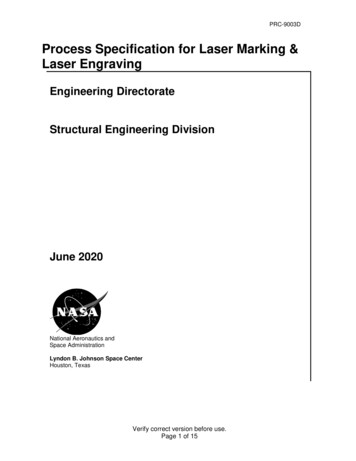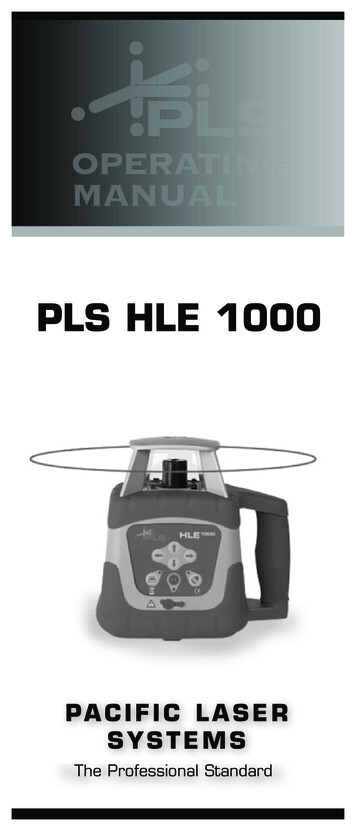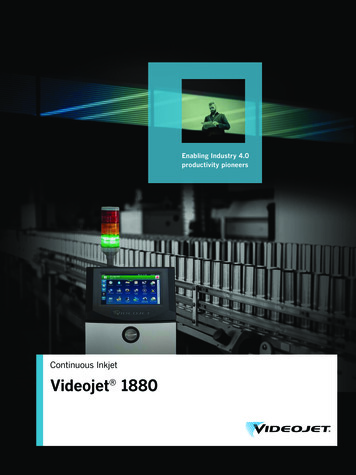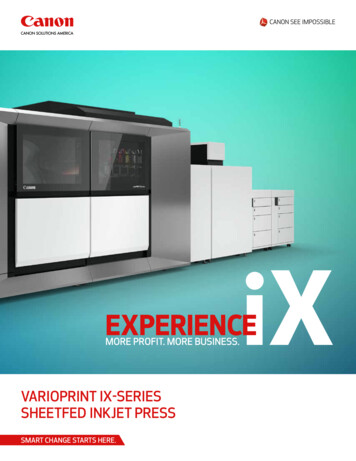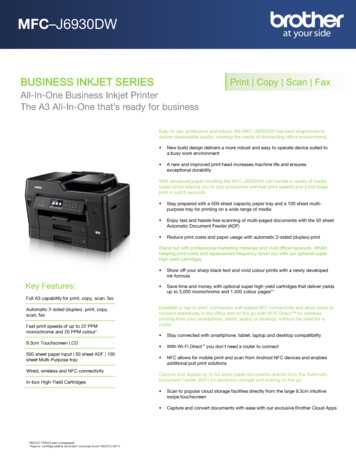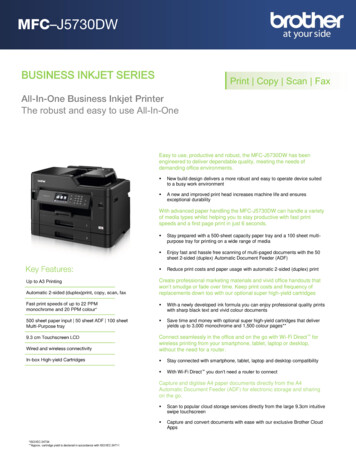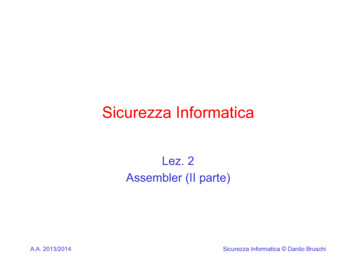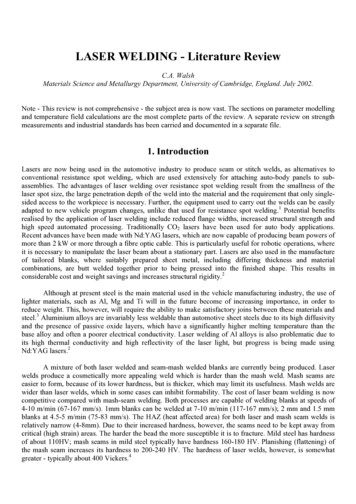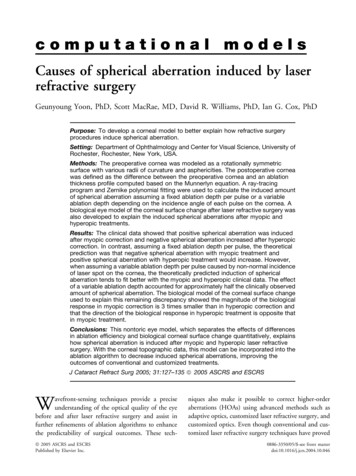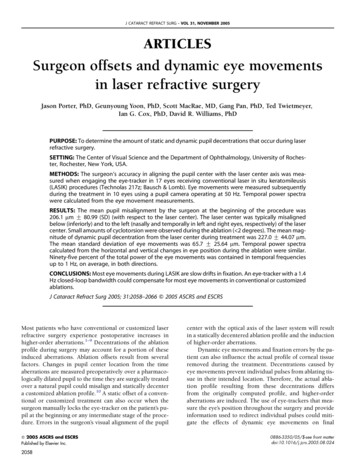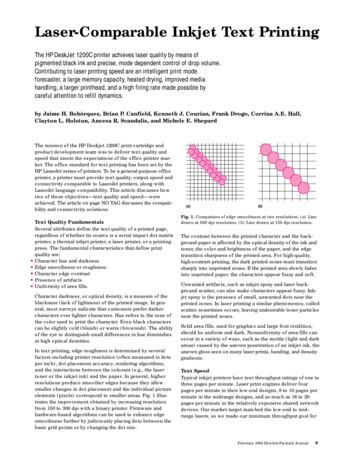
Transcription
Laser-Comparable Inkjet Text PrintingThe HP DeskJet 1200C printer achieves laser quality by means ofpigmented black ink and precise, mode dependent control of drop volume.Contributing to laser printing speed are an intelligent print modeforecaster, a large memory capacity, heated drying, improved mediahandling, a larger printhead, and a high firing rate made possible bycareful attention to refill dynamics.by Jaime H. Bohórquez, Brian P. Canfield, Kenneth J. Courian, Frank Drogo, Corrina A.E. Hall,Clayton L. Holstun, Aneesa R. Scandalis, and Michele E. ShepardThe mission of the HP Deskjet 1200C print cartridge andproduct development team was to deliver text quality andspeed that meets the expectations of the office printer market. The office standard for text printing has been set by theHP LaserJet series of printers. To be a general-purpose officeprinter, a printer must provide text quality, output speed andconnectivity comparable to LaserJet printers, along withLaserJet language compatibility. This article discusses howtwo of those objectives—text quality and speed—wereachieved. The article on page NO TAG discusses the compatibility and connectivity solutions. Text Quality FundamentalsSeveral attributes define the text quality of a printed page,regardless of whether its source is a serial impact dot matrixprinter, a thermal inkjet printer, a laser printer, or a printingpress. The fundamental characteristics that define printquality are:Character hue and darknessEdge smoothness or roughnessCharacter edge contrastPresence of artifactsUniformity of area fills.Character darkness, or optical density, is a measure of theblackness (lack of lightness) of the printed image. In general, most surveys indicate that customers prefer darkercharacters over lighter characters. Hue refers to the tone ofthe color used to print the character. Even black characterscan be slightly cold (bluish) or warm (brownish). The abilityof the eye to distinguish small differences in hue diminishesat high optical densities.In text printing, edge roughness is determined by severalfactors including printer resolution (often measured in dotsper inch), dot placement accuracy, rendering algorithms,and the interactions between the colorant (e.g., the lasertoner or the inkjet ink) and the paper. In general, higherresolutions produce smoother edges because they allowsmaller changes in dot placement and the individual pictureelements (pixels) correspond to smaller areas. Fig. 1 illustrates the improvement obtained by increasing resolutionfrom 150 to 300 dpi with a binary printer. Firmware andhardware-based algorithms can be used to enhance edgesmoothness further by judiciously placing dots between thebasic grid points or by changing the dot size.(a)(b)Fig. 1. Comparison of edge smoothness at two resolutions. (a) Linedrawn at 300 dpi resolution. (b) Line drawn at 150 dpi resolution.The contrast between the printed character and the background paper is affected by the optical density of the ink andtoner, the color and brightness of the paper, and the edgetransition sharpness of the printed area. For high-quality,high-contrast printing, the dark printed zones must transitionsharply into unprinted zones. If the printed area slowly fadesinto unprinted paper, the characters appear fuzzy and soft.Unwanted artifacts, such as inkjet spray and laser background scatter, can also make characters appear fuzzy. Inkjet spray is the presence of small, unwanted dots near theprinted zones. In laser printing a similar phenomenon, calledscatter, sometimes occurs, leaving undesirable toner particlesnear the printed zones.Solid area fills, used for graphics and large font rendition,should be uniform and dark. Nonuniformity of area fills canoccur in a variety of ways, such as the mottle (light and darkareas) caused by the uneven penetration of an inkjet ink, theuneven gloss seen on many laser prints, banding, and densitygradients.Text SpeedTypical inkjet printers have text throughput ratings of one tothree pages per minute. Laser print engines deliver fourpages per minute in their low-end designs, 8 to 10 pages perminute in the midrange designs, and as much as 16 to 20pages per minute in the relatively expensive shared networkdevices. Our market target matched the low-end to midrange lasers, so we made our minimum throughput goal forFebruary 1994 Hewlett-Packard Journal9
WRITINGMirrorCONDITIONINGLaser BeamPrimaryCoronaWireErase LampDEVELOPINGBladeCLEANINGDeveloping CylinderFUSINGCleaningBladeUpper Fuser RollerPhotosensitiveDrumPickup RollerRegistration RollersFeederLower Fuser RollerStatic ChargeEliminatorTRANSFERRINGTransferCoronaFig. 2. HP LaserJet IIIP electrophotographic print engine.high-quality text a true four pages per minute as measuredby industry analysts’ latest printer text benchmarks.Comparing the TechnologiesHP LaserJet printers and HP thermal inkjet printers use significantly different printing technologies. Each process hasinherent advantages and engineering challenges. Fig. 2 illustrates the electrophotographic printing process and Fig. 3shows the inkjet drop generation process. The basics of thethermal inkjet printing engine are described in “An InsideView of the Drop Generation Process” on page 11.Laser printing has several high-value attributes. It provides ahigh degree of media independence, it is a high-speed pageprinting process, it is a dry process that doesn’t wet the paperso physical distortions of the media are minimized, and itproduces durable print unaffected by water and highlighters. Excellent character edge smoothness is achieved by thefusing process and the small toner particle size. Dot size canbe adjusted, and customers perceive the process to behighly reliable.Thermal inkjet printing also has attributes that have beenengineered to deliver customer value. It uses a low-cost printengine (the disposable inkjet cartridge). Printer mechanismsimplicity is possible for low-end designs. It can do singlepass full-color printing and has fewer limitations in producing(a)10(b)February 1994 Hewlett-Packard Journal graphic area fills. The requirements for producing good inkjettext quality and speed can be summarized as follows:Pick a high resolution (300 dpi minimum)Eject uniform drops of the correct size, shape, and velocityat a high frequencyPlace the dots precisely on the paperControl the ink-media interactionMake the printer mechanism fast and intelligent.The rest of this article will describe how the design teamsachieved these goals during the Deskjet 1200C printer andblack ink cartridge development.Controlling Drop Size and ShapeTo provide text and images that are as sharp and crisp aslaser output, the size, shape, and consistency of the dropsmust be controlled. Since the drops are the result of a nucleated bubble, nucleation must be repeatable from firing tofiring. One way to ensure this is to use very narrow heatingpulse widths. By transferring energy to a thin layer of inkover the heating resistor rapidly, defects on the resistorsurface that trap gas do not have a chance to alter thenucleation, so each drop looks like the others.1The print cartridge also needs to be fired very fast (8 kHz)so that the printer will have laser-comparable throughput. Itis easy to make a print cartridge refill this fast, but the trick(c)Fig. 3. Inkjet print engine dropejection process. (a) Nucleation.(b) Bubble growth and dropejection. (c) Refill.
An Inside View of the Drop Generation ProcessThe bulk of the print cartridge for the HP DeskJet 1200C printer is a reservoir—aflexible bag—of ink that is connected to the printhead through a passage calledthe snout. In the printhead there are many small holes, or orifices, through whichink flows to generate the dots on the paper. Unlike most containers that have a setof holes in the bottom, this one will not leak. The ink is held up by a spring in thebag which exerts a force outward on the walls of the bag producing a backpressurethat prevents the ink from drooling. The ink would be pulled up into the mainreservoir away from the printhead if it were not for opposing capillary forces fromthe exit orifices, which pull back on the ink, holding it in static equilibrium.meniscus to climb up the exit orifice, drawing a new charge of ink into the chamberbehind it. That charge is pulled against the resistance of the spring bag and thechoked refill channel. The inertia of this charge causes the ink to bulge out the exitorifice, which starts to pull back on the overshooting meniscus as soon as it passesthe exit plane. Eventually the ink flow is reversed by this force, causing the bulgeof ink to return to the drop generation chamber. Over a few cycles this bouncingmeniscus damps out and returns to equilibrium. The system is intentionally underdamped to increase the speed with which the ink first crosses the equilibriumplane.Imagine yourself inside one of the drop generators that exists above each exitorifice. Below you is the hole, which does not drool, thanks to the gentle balanceof spring-bag and capillary forces. You are surrounded by a square chamber thathas a refill channel cut into one wall, providing access to the reservoir of ink andrestricting the flow enough to stabilize the refill process. The ceiling is covered bya flat, square, thin-film resistor, which is connected through an electrical circuit topower circuitry in the printer.The point at which a new firing cycle is initiated in this refill process has a lot todo with the shape and consistency of the droplets produced (see Fig. 1). If the nextfiring is well after the meniscus bouncing damps out, the next droplet will be aswell-formed as the first. Unfortunately, the repetition frequency that can be achievedin this way is usually too slow to meet the print speed goals. If firing is attemptedbefore the first meniscus equilibrium crossing, then the drops will be fast andspear-shaped, leading to poor print quality. If the next firing occurs near the largest excursion of the refill charge outside of the orifice, the drops will be slow anddumbbell-shaped, again leading to poor print quality. Between these two pointswell-formed drops can be produced that do produce optimum print quality. This isthe earliest point in the refill process that well-formed drops can be produced.The drop ejection process is shown in Fig. 3 on page 10. It begins suddenly as theceiling heats up hundreds of degrees Celsius per microsecond. Because the temperature rise is so fast, only a very thin layer of the ink that is in contact with theresistor heats up with it. As that fluid reaches its boiling temperature any small airbubble trapped on the surface will start to grow. However, around the bubble theink is still heating. When it reaches its superheat temperature limit, the ink can nolonger exist in the liquid state because of thermodynamic instability. The ink rapidly vaporizes, creating a pressure wave that acts like a piston to fire the slug ofink in the chamber (with you entrained within it) out of the chamber and throughthe exit orifice. As the ink slug leaves, air rushes in around it, filling the space thathad been occupied by the ink. The air rushes around the ink droplet as the tailbreaks off and the ink remaining in the chamber reforms to produce a meniscus, oran air-to-ink interface, which connects by surface tension to the smooth innerwalls of the exit orifice.While the new charge is being prepared for the next shot, the last drop travelsacross the printhead-to-media gap and hits the media. If the drop is well-formed,both the head and the tail of the drop will hit the media in the same spot. On themedia a new set of processes take over. The media must first begin to wet, overcoming its resistance to penetration of the ink into it. This happens quickly withHP inks, and the processes of ink penetrating into the media, of ink wicking alongfibers on the surface of the media, and of the ink’s volatile components evaporating off begin in parallel. The rate at which each of these processes happens relative to the others affects the print quality. More detail on these processes can beobtained from the accompanying article and the article on page NO TAG.The meniscus shape is distorted by many factors: the shape of the vaporized inkpiston, the state of the fluid’s velocity field immediately before vaporization, andthe imbalances in the wetting of the exit orifice by the ink. However confused thissurface may be, the capillary forces still dominate the force balance, causing theBrian P. CanfieldSenior Member, Technical StaffInkjet Supplies Business UnitVelocity or Drop VolumeMeniscus PositionSpot SizeFirst DropLog Frequency or1TimeSecond DropBimodal Operationor SprayFig. 1. Meniscus dynamics and drop volumeas a function of drop frequency.February 1994 Hewlett-Packard Journal11
TailInk Droplet35 s s45 s sFig. 4. Tail of ink droplet with satellites at different times after dropejection.is to do it and not have the ink rush in with such momentumthat it overflows the orifice and spills out onto the top plate.This effect, called puddling, will pull the following drops inthe direction of the puddle. This results in the drop landingoff-target, and can cause it to break up into spray drops. Thedimensions of the pipe refilling the chamber are adjusted toachieve the right balance between refill speed and fluidicdamping. Drops can also land off-target if all of the parts ofthe system (resistor, barrier, and orifice) are not well-aligned.One characteristic of the pigmented ink used in the DeskJet1200C black print cartridge is that the tail of the drop tendsto stay together much longer than with the dye-based inksused in previous HP inkjet print cartridges. This is an advantage in that it does not break up into random, uncontrollablespray droplets. It is also a disadvantage because anythingthat disturbs the symmetric nature of the tail may cause it toform one or two large, consistent spray droplets we call
HP LaserJet IIIP electro-photographic print engine. Photosensitive Drum Feeder Static Charge Eliminator Transfer Corona Lower Fuser Roller Upper Fuser Roller FUSING CONDITIONING WRITING Laser Beam Erase Lamp CLEANING Primary Corona Wire Cleaning Blade DEVELOPING Developing Cylinder Mirror Registration Rollers TRANSFERRING Blade Pickup Roller high-quality text a true four pages per
